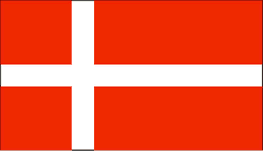|
|
Denmark
|
|
Denmark is a small kingdom in northern Europe that is almost surrounded by water. It consists of a peninsula and 482 nearby islands. The peninsula, called Jutland, shares a 68-kilometre border with Germany.
Greenland, off the northeastern coast of Canada, is a province of Denmark even though it lies 2,090 kilometres away.
The Faeroe Islands, north of Scotland, are a self-governing part of the Danish kingdom. Denmark, along with Norway and Sweden, is one of the Scandinavian countries.
A Short Background
Once the seat of Viking raiders and later a major north European power, Denmark has evolved into a modern, prosperous nation that is participating in the political and economic integration of Europe.
So far, however, the country has opted out of some aspects of the European Union's Maastricht Treaty, including the economic and monetary system (EMU) and issues concerning certain internal affairs.
Geography
With an area of just 43,069 square kilometers (16,629 square miles), Denmark is a small, relatively flat nation encompassing the Jutland Peninsula and roughly 500 islands (100 of which are inhabited).
This complex of islands makes travel somewhat like an amusement-park ride, with combinations of trains, buses, and boats coming into play any time travelers want to move from one island to the next. Jutland, the country's largest area, has a varied landscape, from the dunes and flat meadows of the east coast to the more dramatic cliffs of the west coast. It is here that Denmark is connected to Europe.The highest hill, at 173 meters (568 feet), is Yding Skovhoj in Jutland. On Funen, northeast of Faborg, are the Svanninge Bakker, low hills that are nonetheless high enough to offer a panorama of the islands south of Funen. Denmark is an agricultural country, with three-quarters of the land devoted to farming.
As you drive across the country, you'll notice the unique farm buildings called gaards. The thatched roofs on so many of the half-cottages are uniquely Danish. They are made from rush harvested from fresh-water lakes and are expensive both to construct and to insure, but many Danes persevere, not wanting to relinquish a long-standing tradition.
Population: 5,352,815 (July 2001 est.)
Languages: Danish, Faroese, Greenlandic (an Inuit dialect), German (small minority)
note: English is the predominant second language
Currency: Danish krone (DKK) note - the Danes rejected the Euro in a 28 September 2000 referendum
Exchange rates: 1 EURO to Danish Krone: 7,439 (April 2004)
Location: Northern Europe, bordering the Baltic Sea and the North Sea, on a peninsula north of Germany (Jutland); also includes two major islands (Sjaeland and Fyn)
Geographic coordinates: 56 00 N, 10 00 E More Informations:
Have a look at this pdf-file for information about the dance Little man in a fix
To read the file you need the free software Adobe Reader from Adobe or another pdf-viewer.
The Adobe Reader you can find on the homepage from Adobe under Support - Downloads.


